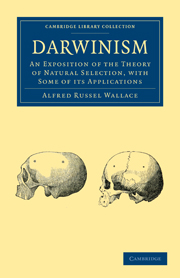Book contents
- Frontmatter
- Preface
- Contents
- LIST OF ILLUSTRATIONS
- CHAPTER I WHAT ARE “SPECIES” AND WHAT IS MEANT BY THEIR “ORIGIN”
- CHAPTER II THE STRUGGLE FOR EXISTENCE
- CHAPTER III THE VARIABILITY OF SPECIES IN A STATE OF NATURE
- CHAPTER IV VARIATION OF DOMESTICATED ANIMALS AND CULTIVATED PLANTS
- CHAPTER V NATURAL SELECTION BY VARIATION AND SURVIVAL OF THE FITTEST
- CHAPTER VI DIFFICULTIES AND OBJECTIONS
- CHAPTER VII ON THE INFERTILITY OF CROSSES BETWEEN DISTINCT SPECIES AND THE USUAL STERILITY OF THEIR HYBRID OFFSPRING
- CHAPTER VIII THE ORIGIN AND USES OF COLOUR IN ANIMALS
- CHAPTER IX WARNING COLORATION AND MIMICRY
- CHAPTER X COLOURS AND ORNAMENTS CHARACTERISTIC OF SEX
- CHAPTER XI THE SPECIAL COLOURS OF PLANTS: THEIR ORIGIN AND PURPOSE
- CHAPTER XII THE GEOGRAPHICAL DISTRIBUTION OF ORGANISMS
- CHAPTER XIII THE GEOLOGICAL EVIDENCES OF EVOLUTION
- CHAPTER XIV FUNDAMENTAL PROBLEMS IN RELATION TO VARIATION AND HEREDITY
- CHAPTER XV DARWINISM APPLIED TO MAN
- INDEX
CHAPTER IV - VARIATION OF DOMESTICATED ANIMALS AND CULTIVATED PLANTS
Published online by Cambridge University Press: 29 August 2010
- Frontmatter
- Preface
- Contents
- LIST OF ILLUSTRATIONS
- CHAPTER I WHAT ARE “SPECIES” AND WHAT IS MEANT BY THEIR “ORIGIN”
- CHAPTER II THE STRUGGLE FOR EXISTENCE
- CHAPTER III THE VARIABILITY OF SPECIES IN A STATE OF NATURE
- CHAPTER IV VARIATION OF DOMESTICATED ANIMALS AND CULTIVATED PLANTS
- CHAPTER V NATURAL SELECTION BY VARIATION AND SURVIVAL OF THE FITTEST
- CHAPTER VI DIFFICULTIES AND OBJECTIONS
- CHAPTER VII ON THE INFERTILITY OF CROSSES BETWEEN DISTINCT SPECIES AND THE USUAL STERILITY OF THEIR HYBRID OFFSPRING
- CHAPTER VIII THE ORIGIN AND USES OF COLOUR IN ANIMALS
- CHAPTER IX WARNING COLORATION AND MIMICRY
- CHAPTER X COLOURS AND ORNAMENTS CHARACTERISTIC OF SEX
- CHAPTER XI THE SPECIAL COLOURS OF PLANTS: THEIR ORIGIN AND PURPOSE
- CHAPTER XII THE GEOGRAPHICAL DISTRIBUTION OF ORGANISMS
- CHAPTER XIII THE GEOLOGICAL EVIDENCES OF EVOLUTION
- CHAPTER XIV FUNDAMENTAL PROBLEMS IN RELATION TO VARIATION AND HEREDITY
- CHAPTER XV DARWINISM APPLIED TO MAN
- INDEX
Summary
Having so fully discussed variation under nature it will be unnecessary to devote so much space to domesticated animals and cultivated plants, especially as Mr. Darwin has published two remarkable volumes on the subject where those who desire it may obtain ample information. A general sketch of the more important facts will, however, be given, for the purpose of showing how closely they correspond with those described in the preceding chapter, and also to point out the general principles which they illustrate. It will also be necessary to explain how these variations have been increased and accumulated by artificial selection, since we are thereby better enabled to understand the action of natural selection, to be discussed in the succeeding chapter.
The facts of Variation and Artificial Selection.
Every one knows that in each litter of kittens or of puppies no two are alike. Even in the case in which several are exactly alike in colours, other differences are always perceptible to those who observe them closely. They will differ in size, in the proportions of their bodies and limbs, in the length or texture of their hairy covering, and notably in their disposition. They each possess, too, an individual countenance, almost as varied when closely studied as that of a human being; not only can a shepherd distinguish every sheep in his flock, but we all know that each kitten in the successive families of our old favourite cat has a face of its own, with an expression and individuality distinct from all its brothers and sisters.
- Type
- Chapter
- Information
- DarwinismAn Exposition of the Theory of Natural Selection, with some of its Applications, pp. 83 - 101Publisher: Cambridge University PressPrint publication year: 2009First published in: 1889



